 List of Abstracts List of Abstracts
 Abstracts Abstracts
 Second flyer Second flyer
 First flyer First flyer
With support:

|
Venue
General facts about St Petersburg
Founded by Tsar Peter I of Russia in 1703, St Petersburg was the capital of the Russian Empire for more than two hundred years. It is Russia's second largest city after Moscow. The city has 4.6 million inhabitants, and over 6 million people live in its metropolitan area. Saint Petersburg is a major European cultural center, and an important Russian port on the Baltic Sea.
Saint Petersburg is often described as the most Western city of Russia. The city is sometimes referred to in Russia as its northern capital. A large number of foreign consulates, international corporations, banks and other businesses are located here. It is also worldknown for its channels and bridges and is often called "Northern Venice".
Owing to the high northern latitude at 60 degrees, summer Sun does not set in St Petersburg until after 10-11 p.m., and the twilight lasts much longer. These few weeks around the summer solstice in June are known as the White Nights, when sunsets are late, sunrises are early and darkness is never complete. The White Nights are a time of the Festival in St Petersburg. The White Nights Festival consists of a series of classical ballet, opera and music events and includes performances by Russian dancers, singers, musicians and actors, as well as famous international guest stars. The Scarlet Sails celebration is the culmination of the White Nights season, the largest public event anywhere in Russia with the annual estimated attendance about one million people, most of whom are students from hundreds of schools and colleges, both local and international.
|
About RSHU
Russian State Hydrometeorological University offers courses at all levels of higher professional education leading to BA, MA, Specialist, Candidate (equivalent to PhD) and Doctor of Sciences degrees in the area of environmental studies. RSHU is also a Regional Training Center component of the World Meteorological Organization, and supports many active research programmes.
The university has been an innovator in introducing new education and training approaches and curricula, and has hosted regional and international workshops on innovations in education and training.
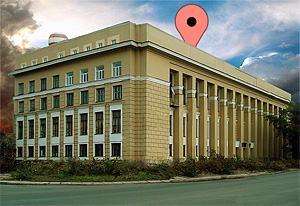
|
Climate
Saint Petersburg experiences a humid continental climate of the cool summer subtype, due to the distinct moderating influence of the Baltic Sea cyclons. The average annual temperature is +4 °C (39 °F). The River Neva within the city limits usually freezes up in November-December, break-up occurs in April. From December to March there are 123 days average with snow cover, which reaches the average of 24 cm (9 in) by February. The frost-free period in the city lasts on average for about 135 days. The city has a climate slightly warmer than its suburbs. Weather conditions are quite variable all year round. Average annual precipitation varies across the city, averaging 600 mm (24 in) per year and reaching maximum in late summer. Soil moisture is almost always high because of lower evapotranspiration due to the cool climate. Air humidity is 78% on average, while overcast is 165 days a year on average.
|
| Month |
Jun |
Jul |
| Record high °C (°F) |
34.6 (94) |
34.3 (94) |
| Average high °C (°F) |
19.4 (67) |
22.0 (72) |
| Average low °C (°F) |
10.8 (51) |
13.9 (57) |
| Record low °C (°F) |
0.1 (32) |
4.9 (41) |
| Precipitation mm (inches) |
57 (2.24) |
77 (3.03) |
Weather forecasts 
|
City map
Download large map (2600 x 1600, jpg, 2Mb)
Main city attractions
On the sightseeing tour across the city of Saint Petersburg, the visitors are assured an enthralling time. The historical monuments and religious structures present here are just awe-inspiring.
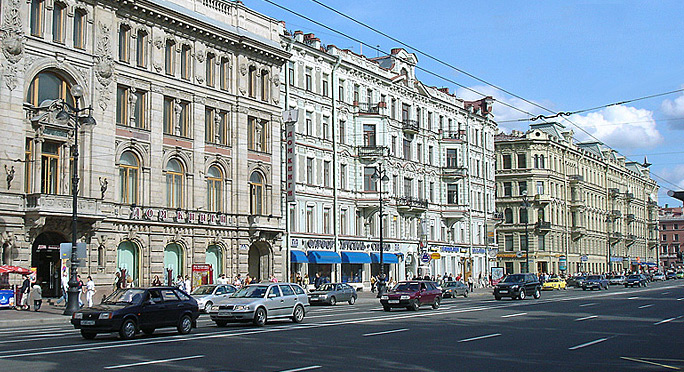
|
The Nevskiy Prospect is the main avenue of St.Petersburg, an easy choice for a first St Petersburg walk.
It is the centre of business and trade activities and cultural life of the city, a prime place for shopping, entertainment and nightlife.
|
A walk down Nevskiy is a walk into the heart of the new Russia: a buzzing, swirling mishmash of new and colorful shops, restaurants, bars, cinemas, art galleries, largest banks and perfumeries packed to overflowing with tourists and natives, workers and beggars, people selling their pets and shoes, scam runners, pickpockets and purse snatchers, yahoos and religious fanatics - all shoving past on their way to the action.
In 1718-1719 the Prospect was hewed through the swampy ground of the dense wild forest, which covered the territory at that time. The Nevskiy Prospect appeared in 1710 as two roads leading from the Admiralty and from the Alexander Nevskiy Monastery to the Old Novgorod high road, but it quickly became adorned with beautiful buildings, squares and bridges and became the very center of the bustling, rapidly growing city. From the very beginning Peter the Great kept a close eye on the development of the Prospect to make sure all the buildings were constructed in the same High style and formed a single line of facades interrupted only by the Canals or Rivers. The part from the Admiralty to the present Square of Insurrection was known as a Big Prospect, which was the main entrance to the city. In the thirties of the 18th century the road was called the Neva Prospect. In the sixties of the 18th a singe thoroughfare was formed which from the end of the 18th century acquired the present name of Nevskiy Prospect. Though the Soviets tried renaming it 25th of October Avenue in honor of their revolution, the name never stuck.
At the beginning of the 1900s, it was one of Europe's grandest boulevards, with cobble-stoned sidewalks and a track down the middle for horse-drawn trams. On cither side of the tracks were wooden paving blocks to muffle the sound of horse-drawn carriages - an innovation that was apparently the first in the world and for which the prospect was dubbed the quietest main street in Europe. Today this is a four and a half kilometres long range of beautiful buildings, running from the Admiralty to the Moscow Railway Station and then, after a slight turn, to the Alexander Nevskiy Lavra. Pushing through its crowds is an essential St.Petersburg experience, and if you're there on a holiday evening (like City Day), the sight of thousands pouring like a stream down its middle is one you'll not soon forget.
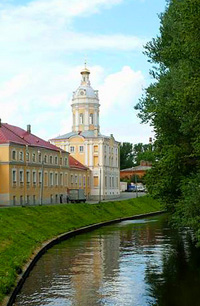
|
The Alexander Nevsky Lavra
The Alexander Nevsky Lavra is situated at the end of Nevsky Prospekt, just across the square from Moscow hotel. Peter the Great founded the Lavra in 1710 as "The Monastery of Holy Trinity and Grand Duke, St.Alexander Nevsky" to honor the victory of the Grand Duke of Novgorod over the Swedish troops in the Neva battle in 1240.
The construction of the stone Monastery town began in 1717. On August 30, 1724 by the order of Peter the Great the remains of St. Alexander Nevsky were transferred to the new church of the Annunciation and St.Alexander Nevsky. Peter the Great conceived the Monastery as the chief orthodox monastery of Russia.
In 1726 the Slavonic/Greek/Roman seminary was established here. Later on the Academy of Theology (which operates now) was organized. The Highest priests of the Orthodox Church hierarchy were educated in the Theological School located here. In 1797 the Monastery was transformed into the Laura (the word can be translated as "abbey") with the large historical archive and library. In 1909 the Museum of Lavra was established. The Metropolitan Garden, the Lazarev cemetery (now the Necropolis of the 18th century), the Tikhvin cemetery (now the Necropolis of People of Arts), and Nicholay cemetery occupy a large plot of the Lavra territory. Many Russian luminaries were buried here.
The part of Nevsky prospect between the Square of Insurrection and the Alexander Nevskiy Square is traditionally called Old Nevskiy Prospect.
|
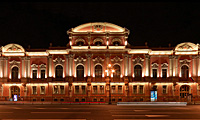
|
Beloselsky-Belozersky Palace
The red 1840s Beloselsky-Belozersky Palace, at Nevskiy 41, provides a photogenic baroque backdrop. It now houses a rather amusing Wax Museum. Between the Fontanka and Moscow Station, Nevskiy Prospect has fewer historic buildings but heaps more chi-chi shops and cinemas, and in the center of the strip is the Sheraton Nevskij Palace Hotel.
|
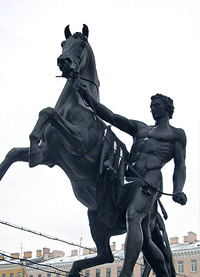
|
Anichkov bridge
Nevskiy Prospect crosses the Fontanka on the Anichkov bridge, with famous 1840s statues (sculpted by the German Klodt) of rearing horses at its four comers.
The Anichkov Palace (1741-1750, the city's second palace), between ploshchad Ostrovskogo and the Fontanka River (its main facade faces the river and was once joined to it by a canal), was home to several imperial favourites, including Catherine the Great's lover Grigory Potyomkin (who graciously accepted it as a gift from her). A slew of architects, including Rastrelli and Rossi, worked on it. It became the city's largest Pioneer Club headquarters after 1935 and to this day houses over 100 after- school clubs for over 10,000 children.
|
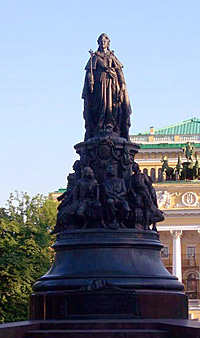
|
Catherine the Great
An enormous statue of Catherine the Great stands on Ostrovskogo Square. The statue depicts, according to the Blue Guide, 'The towering figure of the Empress standing above her close associates'. Well, at least three of these were her known lovers: Orlov, Potyomkin and Suvorov.
This airy square, commonly referred to as the Catherine Gardens, was created by Carlo Rossi in the 1820s and 1830s, and its west side is taken up by the lavish National Library of Russia, St.Petersburg's biggest with some 31 million items, nearly a sixth of which is in foreign languages.
|

|
Alexandrinsky Theatre
Rossi's Alexandrinsky Theatre at the south end of the square is one of Russia's most important. In 1896 the opening night of Chekhov's The Seagull was so badly received here that the playwright fled to wander anonymously among the crowds on Nevskiy Prospect.
More information about Alexandrinsky Theatre
|

|
Street of Zodchey Rossi
Behind the theatre, on ulitsa Zodchego Rossi, is a continuation of Rossi'sensemble. It is proportion deified: it's 22m wide and high and 220m long. The Vaganova School of Choreography situated here is the Kirov Ballet's training school, where Pavlova, Nijinsky, Nureyev and others learned their art.
No sooner had the Prospect been laid, than the first stone Gostiny Dvor was built to bring together all the scanty shops scattered all over the city. In 1736 it was burnt to the ground by fire and twenty years later Rastrelli was commissioned to design a new department store called the Grand Gostiny Dvor at the corner of the Nevskiy Prospect and the Sennaya street. The construction of the ornate Baroque building had been already under way when the investors cut off the funding. They hired a less ambitious architect Delamote and in 1785 he constructed the two-storey and more than one kilometre long Classical building without any extra decoration. Later the so-called "silver rows" for the sale of silver-work and jewellery were built west of the Grand Gostiny Dvor.
|
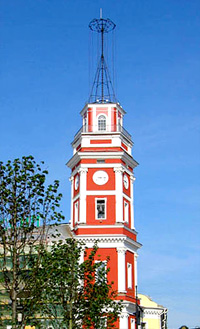
|
City Duma
In 1799 the high tower was added to the buildings and after the silver rows were a bit rearranged the whole ensemble served as the City Duma, the tower with the clock on ulitsa Dumskaya, an institution of the St.Petersburg's local government. Besides, the building served as a kind of cultural centre. Its activity ranged from chamber concerts of the Russian Musical Society to poetical and literature assemblies attended by Fyodor Dostoevsky, Alexander Blok and Sergei Yesenin.
|
|
|
Gostiny Dvor
Although it originally consisted of just 178 separate shops, Gostiny Dvor was severely damaged during the 900-day Siege of Leningrad and was subsequently renovated to vastly increase its trading space and become the largest store in St.Petersburg. A quarter of the expansive complex is currently under renovation but the store remains open for business. One- fourth of the complex is currently under renovation, and a long wooden fence stretching along Nevskiy has become a St.Petersburg version of London's Hyde Park Speakers Corner, attracting activists from different parties, special interest groups and what not... The fence was recently removed but the "Speaker's Corner" is still there.
Today Gostiny Dvor is a huge department store, which is being gradually turned into a shopping mall, since a significant part of its 164,690 square feet of trading space is rented out to smaller shops.
On the other side of Nevskiy, in the arcade at No 48, the Passazh department store is beautiful to look at (notice the glass ceilings) and packed with pricey goods, but has a decidedly less than exciting atmosphere. Downstairs in the basement, there's a well-stocked Western supermarket.
|
|
|
Kazan Cathedral
Unique building of Kazan Cathedral ("Kazansky sobor") or The Cathedral of Our Lady of Kazan on Nevskiy Prospect immediately attracts one's attention. The Kazan Cathedral encircles a small square with a double row of beautiful columns - an impressive colonnade (96 13 metre high columns). The architect Andrey Voronikhin, who built this church in 1801-1811, was greatly inspired by the St,Peter's Basilica in Rome. The Kazan Cathedral was thought to be a Russian version of St.Peter's and to become the main church of Russia.
It was planned in the shape of the Latin Cross. Voronikhin had a difficult task to solve. The matter was that in keeping with the church canons the altar was to face eastwards, hence the main entrance and the facade faced westwards. Thus Nevskiy Prospect was to front the side facade of the cathedral, and not the main one. Voronikhin solved the problem supplying the cathedral with a grand semicircular colonnade opening on the Prospect that added to its beauty. Moreover, the cathedral as well as the colonnade were elevated on to a granite socle with wide staircases. The wings of the colonnade that form a square in front of the cathedral have monumental portals at the ends, simultaneously serving as passageways. Voronikhin intended to erect a similar colonnade facing south. The architect Voronikhin who had formerly been Count Stroganov's serf later to become the professor of architecture in the Academy of Arts.
After the War of 1812, during which Napoleon was defeated, the church is considered to be a monument to the Russian victory. Russian soldiers brought French flags and keys from French towns and fortresses to the Cathedral. The Cathedral was named after a "miracle-making" icon of Our Lady of Kazan, which the church housed till the early 1930s. The Bolsheviks closed the Cathedral in 1929, and the liturgy was banned. Since 1932 it housed the collection of the Museum of History of Religion and Atheism, which displayed numerous pieces of religious art and served anticlerical propaganda purposes. A couple of years ago regular services were resumed in the cathedral, though it still shares the premises with the museum, from whose name the word "atheism" has now been omitted.
|
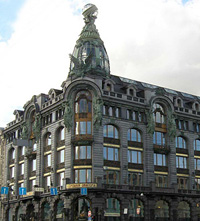
|
Dom Knigi
Opposite the Kazan Cathedral is St.Petersburg's biggest bookshop, Dom Knigi, topped by the globe emblem of the Singer sewing machine company, which constructed the building in 1902-1904. The building also housed the American consulate for a few years prior to WWI. Just behind the Kazan Cathedral, a bit south of the Central Train Ticket Center, sits the Bankovsky bridge, one of St.Petersburg's loveliest bridges. In the block of Nevskiy Prospect over the canal from Kazan Cathedral, pavement artists cluster in front of the Central Art Salon.
|
|
|
Church of Our Savior on the Spilled Blood
Suspended by cables emerging from the mouths of golden-winged griffins, the wooden bridge affords a splendid view north up the Griboedova Canal past Nevskiy Prospect to the picturesque Russian-style Church of Our Savior on the Spilled Blood. In addition to the many churches of different denominations (which prompted the French writer Alexander Dumas to call Nevskiy "the street of religious tolerance") there are many more attractions around. Just a stone's throw from Nevskiy, right by the Grand Hotel Europe, there are Arts Square and the Russian Museum.
The Moyka River (the Narodny Bridge), the Fontanka River (the Anichkov Bridge), and the Griboedova Canal (the Kazan Bridge) cross Nevskiy Prospect.
Translations of the church's name (Khram Spasa na Krovi) vary between guidebooks and include "The Resurrection Church" (Khram Voskresenia Khristova), "The Church of the Resurrection of Christ", "Church of the Redeemer", and the nearly identical "Church of the Bleeding Savior". The moniker "Bleeding Savior" is somewhat arbitrary as this church has twenty different names depending on whom you ask.
This marvelous Russian-style multicolored, onion-domed church was built on the spot where Emperor Alexander II was assassinated in March 1, 1881. On this site a terrorist Grinevitsky, a member of the revolutionary organization People's Will, mortally wounded Tsar, by tossing a bomb at at his royal carriage.
After assuming power in 1855 in the wake of Russia's disastrous defeat in the Crimean war against Britain, France and Turkey, Alexander II initiated a number of reforms. In 1861 he freed the Russian serfs (peasants, who were almost enslaved to their owners) from their ties to their masters and undertook a rigorous program of military, judicial and urban reforms, never before attempted in Russia. However, during the second half of his reign Alexander II grew wary of the dangers of his system of reforms, having only barely survived a series of attempts on his life, including an explosion in the Winter Palace and the derailment of a train.
In 1883 son of Alexander II, Alexander III, began construction of the memorial church and it was completed in 1907 during the reign of Nicholas II. The church resembles Church of St.Basil the Blessed (Pokrovsky Cathedral), located on Red Square in Moscow and its flamboyant Russian style can be attributed to a rise in national consciousness at the turn of the century. Architecturally it revives the traditions of the 17th-century Russian church building.
The construction of the church was almost entirely funded by the Imperial family and thousands of private donators. The church stands out for its complicated and picturesque outline, as well as rich and multicolored decoration. Both the interior and exterior of the church is decorated with incredibly detailed mind-boggling 7000 square meters of mosaics, designed and created in Frolovs' workshop to the originals by the most prominent Russian artists of the day: Vasnetsov, Nesterov, Riabushkin and Vrubel. Interestingly, despite the church's very obviously Russian aspect, its principle architect, Parland, was not even Russian by birth.
The facades are faced with glazed shaped brick and ceramic tiles as well as decorated with mosaic panels. In the decor of interiors Italian marbles and Russian semiprecious stones are used. The church is interesting as a kind of an architectural accent in classical surroundings. On the very spot of the assassination is a marble Shatrovy Cen, a monument to Alexander.
The church was closed for services in the 1930s, when the Bolsheviks went on an offensive against religion and destroyed churches all over the country. It remained closed and under restoration for over 30 years and was finally re- opened in 1997 in all its dazzling former glory .
More information about Church of Our Savior on the Spilled Blood
|
|
|
The Palace Square
The Palace Square (Dvortsovaya Ploshchad) is the most grandiose among the squares of the city. The focal point of its architectural ensemble is the Winter Palace (Zimny dvorets), an architectural masterpiece of the flamboyant Russian Baroque and the royal residence of all the Russian Emperors but Paul. It was built by Rastrelli at the close of the Empress Elizabeth reign, in 1754-1762. The Empress ordered it to show off the grandeur of her Court. Hurry as he did, Rastrelli had not completed the Palace before Elizabeth died and she never saw her dream to come true. To make it look truly imperial Rastrelli resorted to all the advantages of the Russian Baroque. He decorated the edge of the roof with huge bronze figures and reduced the emerald wall space to the minimum disguising it by decorative columns and golden tracery, plastic Amours, vases and sculptures.
The Palace has a dramatically eventful history. During the First World War Nicolas II turned it into a hospital. On the eve of the Revolution it was occupied by the Provisional Government. On October 25,1917 Bolsheviks occupied the Palace and called the occasion the Social Revolution. In the course of the World War II the Palace was damaged by Nazis' air strikes.
Several rooms of the Palace that had been used for the location of unique objects d'art later received the designation of the Hermitage. Then the growing collections found the new accommodations: the buildings of the Small Hermitage, Old Hermitage, the Hermitage Theater and New Hermitage. Nowadays all these buildings belong to the State Hermitage - the largest artistic, historical and cultural museum. It exhibits the paintings of Rubens, Rembrandt, Leonardo da Vinci, Titian and works of many other masters, relics of the past culture of many countries of the world.
The semi-circular facade of the General Stuff of Russian Army and Ministries Building is its southern border. The General Stuff Building is a genius creation of the architect K.Rossi. The portal of the Winter Palace faces the two long buildings of the General Headquarters joint by the Triumphal Arch and thus forming the semicircular boarder of the Palace Square.
Visit a Hermitage's page
|
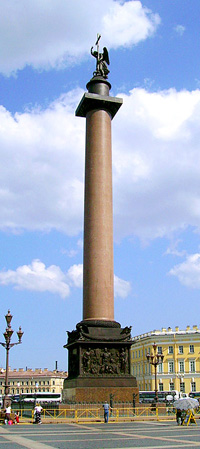
|
Alexander Column
The colossal Alexander Column (Alexandrinskaya Colonna) with the bronze figure of an angel at the top was erected in the center of the Square in 1834 to commemorate the triumphant victory of the Russians over Napoleon in the Patriotic War 1812. It was built by architect Monferran and was named after Emperor Alexander The First. The bronze angel on its top resembles the Emperor Alexander while the snake he is trampling by his cross looks much like Napoleon. This means the victory the good over the evil. The block of red granite was got near Viborg and was delivered by 2 ships to St.Petersburg. The 47,5 meter high column (height of the granite block is 25.5 metres, the lower diametre of the column is 3.66 metres, the upper diametre is 3.16 meters) made of the biggest in the world one-piece marble monolith rests on the porch only by means of its own enormous weight (600 tons) without any supporting clamps. The foundation of the monument consists of 1250 piles each of them is 6 metres length. The block put up by 3000 soldiers and sailors.
Today the Palace Square is the place for all the city's festivals and official performances. Traditionally, the citizens and tourists spend almost all the Russian public holidays here.
|
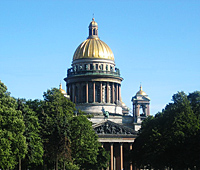
|
Isaac’s Cathedral
One of St. Petersburg’s most extravagant attractions is St. Isaac’s Cathedral, which is located in the heart of the city. Once the largest cathedral in Russia, St. Isaac’s Cathedral is a unique combination of architectural styles and art forms. The cathedral’s interior is embellished with luxurious materials, including marble, lapis lazuli, and malachite. Adorning the cathedral are rich stained glass windows and intricately detailed mosaics. St. Isaac’s Cathedral also contains statues of trumpeting angels and beautiful golden fountains. By climbing the stairs of the cathedral, tourists can get a wonderful panoramic view of the city of St. Petersburg. For the art lover, St. Isaac’s Cathedral displays magnificent examples of Russian artwork and serves as its own living museum.
Visit a Isaac’s Cathedral page
|
|

 List of Abstracts
List of Abstracts Abstracts
Abstracts Second flyer
Second flyer First flyer
First flyer